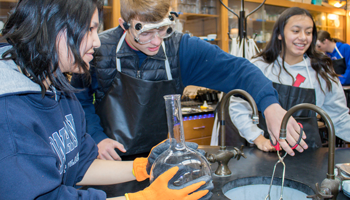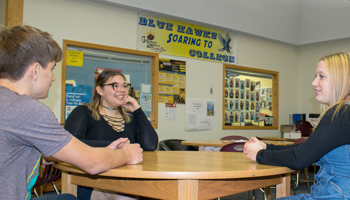Apprenticeships &
Trades Programs
Develop skills as an apprentice and in trades occupations.
Certificate & Two Year Programs
Montana's two-year colleges have programs to jump start your career or fast-track to additional education.
Four Year Programs
If your goal is earning your bachelor’s degree or more, we can help you find the Montana college or university that works best for you.
More Options
to Explore
We have a few more options for you to explore. Think about a starting a career or serving your country?
Education After High School
Almost everyone will need additional education after graduating from high school, and there are many options available to continue your education.
Pro Tip
Things to keep in mind - What kind of education does your potential career require?
Trades
"Trades" is a term that has been around for a long time, and usually when people talk about trades they are referring to occupations that, in today's world, are highly technical, lucrative, and typically require shorter training programs to enter the field. It's a myth that the "trades" are blue-collar jobs that are dirty, dingy, and dead-end.
Read MoreToday, the trades encompass manufacturing, construction, healthcare, energy, information technology and more. When learning a trade you build a specific set of skills that is very desirable for that industry. You can build these skills through an apprenticeship, a certificate, or a degree. There are several advantages to pursuing the trades:
- Affordability: The investment in your education is less because training time is condensed; students can typically graduate from a program with little to no debt, usually in two years or less.
- Jobs are in demand: Across the U.S., communities are experiencing workforce shortages, especially in the trades. Depending on the industry, entry level salaries usually start at $35,000 per year (or more!).
- Career examples include: welder, carpenter, nurse, developer, machinist, construction worker, radiology technician, payroll clerk, and graphic designer.
Take a mental selfie
What do you enjoy doing? What gives you a sense of accomplishment? Do you like to work with your hands? Do you enjoy working on projects with defined beginnings and ends? Do you like variety in your work? If so, you may want to explore opportunities in the trades.
Apprenticeships

An apprenticeship combines classroom learning and on-the-job training, and best of all, pays students while they learn. Apprenticeships generally have a predefined pay scale that outlines how much an apprentice earns as they achieve specific milestones. The time commitment to complete an apprenticeship varies by occupation.
Read MoreWhere can I find more information on how apprenticeships work? Start by visiting the Montana apprenticeship program through the Montana Department of Labor and Industry, and then check out Reach Higher Montana’s apprenticeship program. You may be able to start your apprenticeship when you are still in high school.
Apprenticeship Quick Facts
- Hundreds of Montanans graduate from apprenticeship training each year, many of them earning over $40,000 annually while in training. The average wage after completion of an apprenticeship program is over $60,000 per year.
- Employers have in-demand jobs that need to be filled, so they offer on-the-job training for workers.
- Workers earn while they learn and experience zero to little debt.
- Apprenticeships are a combination of classroom and workplace training. Many apprentices also obtain college degrees and certificates as part of their program.
- Career examples: electrician, auto mechanic, hospital coder, utility technician, construction and more! Apprenticeships are available for occupations outside of the trades, too - like accounting technicians.
Work-Based Learning
Internships and Apprenticeships
Two-Year Colleges and Programs

Montana’s colleges have many two-year programs to choose from. When attending a college within the Montana University System, the credits from a two-year college can easily transfer to a four-year college. If starting at a private institution, talk to your advisor regarding the transferability of credits to and from other institutions.
Explore our Montana Schools page
Read More- Montana’s colleges have many two-year programs to choose from. When attending a college within the Montana University System, the credits from a two-year college can easily transfer to a four-year college. If starting at a private institution, talk to your advisor regarding the transferability of credits to and from other institutions.
- Career examples: paramedic, substance abuse counseling, accounting, network support, webmaster, law enforcement, and more.
Certificate Programs and Certifications
What is a Certificate or Certification?
Certificates and certifications are credentials that you earn to show that you have specific knowledge or specific skills. They are usually tied to an occupation, technology, industry. Generally, you need to pass a test to earn a certification.
- Earning a certificate or certification indicates to employers that you have specialized training to succeed on the job. Some industries require certification to work in particular occupations.
- Certificates are narrow in scope, which allows you to focus on exactly what you need to know and bypass electives.
- Students can quickly elevate their resume as most programs are only a year long, sometimes less.
- Career examples: dental assistant, emergency medical technician, paralegal, network administration, computer programming, welding, construction, pharmacy technician, and more!
- Certification examples: Phlebotomy, Automotive Service Excellence, National Center for Construction, Certified Nursing Assistant, Microsoft Office Specialist, Commercial Driver’s License.
Benefits of Two-Year Colleges
Exploring Higher Education
Pro Tip
To save money, many students start at a two-year school to complete their general requirements or prerequisites and then transition to a four-year school. You can even take classes at a two-year school while you are enrolled in a four-year school, which saves you money!
Four-Year Programs at Colleges and Universities

Montana is home to a variety of public and private colleges and universities offering undergraduate degrees. Completing a four-degree usually involves coursework related to a specific area of study, and is often complemented with additional opportunities for elective study and personal development.
Explore our Montana Schools page
Read More- A bachelor's degree is awarded upon completion of a four-year program of undergraduate study, totaling 120 credit hours.
- Sometimes, it takes longer than four years to earn a four-year degree, as the classes you need may be offered in limited availability.
- Career examples: engineers, journalists, farm, ranch and livestock management, biologist, K-12 teacher, chemist, forestry, social worker, and more.
Pro Tip
Do you know what field of study you want to pursue, but not sure where to start? Login to Montana Career Information System and check out the School Sort tool, under the Education tab, How to Choose a School. This tool allows you to narrow your list of schools to those that match your preferences for location, size, programs of study, and other factors.
Graduate and Professional Degree Programs
Some occupations - like attorneys, doctors, and university professors - require advanced degrees, such as master’s degrees or doctoral degrees. While the overall percentage of occupations requiring an advanced degree is small - only about 4% of jobs in Montana - earning an advanced degree can help prepare you for specialized jobs, or expand your knowledge in a particular field (even if an advanced degree isn’t required).
Read More- Earning a master’s degree usually requires an additional two to three years of study beyond a four-year degree.
- Earning a doctorate degree or PhD can take up to eight years, depending on your course of study.
- It can take ten to fourteen years to become a doctor. This includes completion of a four-year undergraduate degree, at least four years of medical school, and three to seven years in a residency program.
Choosing a College

With almost 4,000 degree-granting institutions in the United States, finding the college that fits you best can seem like an overwhelming project. College is a big investment, so finding the right college for you is an important decision.
Things to keep in mind when researching college options:
- Cost of attendance: Several factors go into the cost of attendance at a college, including tuition, fees, books, housing, meals and more. Financial aid may offset some of these costs, and the aid offered to you may vary by campus.
- School Size and Location: Would you feel lost or thrive in a big campus setting?
A large school can feel like a tiny city, which may overwhelm some students. While on the other hand, someone might feel claustrophobic at a small school. If you can, visit the campuses you are considering to decide which is the right fit for you. - In-State or Out-of-State: Is it important for you to be able to go home on holidays or weekends? Is there another state that you’d like to live in one day? These are factors to consider when choosing a college. Often, in-state schools are more affordable than out-of-state schools.
- Student Services Available: Do you need the support of faculty (teachers), or are you okay being on your own? The institution you choose to attend, as well as the major you pursue, will impact the amount of support you receive from your faculty.
- Program Offerings: Do they have the courses you need to take for your career path? Take a look at the websites of the schools you’re considering to see which programs and courses they offer.
- Special Opportunities: Do they have opportunities like internships or international studies that you may be interested in? College websites offer lots of information about internship and career services, study abroad programs, and more.
Explore our Montana Schools page
School visits and college fairs provide a great opportunity for students to learn more about the schools they are interested in.
Read MoreExploring Your Options
Often, campuses send representatives to high schools to visit with students. If a campus is visiting your high school and you have the time available, take advantage of these opportunities to learn more about the offerings at different colleges.
College Fairs
Each fall, MontanaColleges.com hosts college fairs in high schools across Montana. This is a fantastic opportunity to visit with colleges in Montana (and beyond) in one place.
Visit Campus
Most campuses offer group and individual tours all year round so that students can get a personal feel to see if the college is the right fit for them. Tours are led by students, for students, so you can ask them real questions and get honest answers. What’s dorm life like? Did you get homesick? Are professors easy to talk to?
If you have a road trip coming up, consider including a campus tour. Even if you don’t think the college is the right fit, tour it anyway. This is the best process to discover what you like and don’t like about campuses.
Choosing a College
Benefits of In-State Schools
Going Out-of-State?
We know that many high school students in Montana will be looking at options to go to college or career training out-of-state. Here are a few tips to keep in mind to help you make the best decision for your future.
Read More- Affordability: Almost all out-of-state schools have higher tuition for non-residents. Not only that, but costs may be higher for things like housing, transportation, and food. What options are available to reduce the cost of attendance?
- Adapting to a new climate: Do a little research to see what the weather is like and how you might have to adapt coming from a state with weather like Montana.
- Making Friends: You might not know anyone at an out-of-state school, at least not right away. Are you comfortable finding and making new friends?
- There’s No Place Like Home: Getting home might not be easy. You may not be able to travel back home regularly, maybe only holidays or in the summer, if at all. Can you handle this practically and emotionally?
Pro Tip
Many schools in the western part of the U.S. take part in the Western Undergraduate Exchange (WUE) program that can reduce the cost of tuition for Montana students.
Applying for College
General Requirements for Montana Colleges:
- Apply online: High school students across Montana can apply to Montana University System colleges using one application with NO application fee by visiting Apply Montana.
- High school transcript: Colleges like to see both the unofficial transcript, which is the record of grades up to your junior year, as well as an official transcript following high school graduation. The unofficial transcript is sent in conjunction with the college application and the official transcript is sent at a later date.
- ACT/SAT scores: Colleges may ask for a self-reported score or results may be sent to the school directly from the testing organization. When you take your test, you will have the option to list the schools you’d like to receive your test scores.
- References: Letters of reference are typically from individuals you have worked with in and outside of school. References could be an educator, a counselor, an employer, or someone you help through volunteering.
- Essays: Schools may require an essay pertaining to why you want to attend their college or why they should choose you for admission. Include in your essay your academic strengths and achievements, athletic participation, time management skills, character strength, volunteer hours, or something you’re passionate about. You may also be able to use these same essays to apply for scholarships and grants.
More Options

Not sure what to do right after high school? You can also gain experience by getting a job, or serving your country through the military, AmeriCorps, or Peace Corps.
Straight to Career
Sometimes, the best path for you may be to gain experience working immediately after high school. If that’s the case, it is vitally important that you have a strategy or plan in place to get the most out of going straight into a career.
Read MoreThe first step is to start planning. You want to be ready for this path you have chosen before you finish high school so that no time is wasted in reaching your goals. What career path best suits your interests? What jobs can you do to gain more experience for the career you ultimately want? How much money will you need to make to support yourself?
These are just a few of the questions to ask yourself in your quest to gain independence, life experience, and learn more about yourself. If your goal is to go to college or a career training school later on, learn what the costs will be to attend the school and have a plan for saving money to offset that cost of attendance.
Lastly, keep a journal (or at least make some notes) about your work experience so that you can look back on what you learned. You will find this info helpful when deciding on education options or preparing for future interviews.
Military
For some students, the military is an option to consider. This option requires a high level of dedication as most enlistments require a four-year active duty commitment and two years of inactive duty. Explore this option by visiting todaysmilitary.com, a site produced by the Department of Defense that includes all the military sectors.
Read MoreReserve Officers’ Training Corps, or ROTC, is another option for students to consider. ROTC is a program of study taken in addition to regular college courses. The program includes leadership, management, and professional knowledge classes as well as “hands-on” experiences. Students make a commitment to the military and in return, they earn scholarships that cover the cost of college attendance. For more information about ROTC options in Montana.
The military opened up so many doors for me, I was getting better and better jobs, plus it turned me into something I didn't know I was.
Military Careers & Higher Education
Options after High School - Military
Service Learning: AmeriCorps, Peace Corps, and More
From environmental stewardship to supporting community development, service learning opportunities are excellent options for students to make the world a better place. Through hands-on learning, service members develop leadership skills and address real-world issues. In addition to experience, some service learning opportunities provide education awards that can help pay for college or pay down student loan debt.
Read MoreAmeriCorps
AmeriCorps provides service learning opportunities in programs throughout the country. Service time ranges from a minimum of 300 hours, up to a maximum of 1,700 hours (or three to twelve months). You can apply to serve in your own community or choose to serve somewhere else. Programs are available in all U.S. states and territories, and serve a wide range of community needs, including:
- Community and Nonprofit Development
- Disaster Services
- Economic and Workforce Development
- Education
- Energy and Conservation
- Health and Nutrition
- Legal Assistance
- Tribes and Native American Affairs
- Veterans and Military Families
- Youth Development and Mentoring
AmeriCorps members earn a stipend while serving to help cover basic costs of living, and receive an education award upon completion of service.
- National Service in Montana: There are 15 different AmeriCorps programs and projects in Montana. To learn more, visit Serve Montana, the Governor’s Office of Community Service.
- National Service outside of Montana: Explore hundreds of National AmeriCorps service opportunities.
Peace Corps
Interested in service on a global scale? The Peace Corps might be an option for you. Being part of the Peace Corps is a great way to learn more about the world, expand your horizons, and serve a community in need. Some positions require a college degree. If you don’t have a degree but do have some education and a few years of job experience, you may still be eligible to serve. You might also need to be fluent in a foreign language for some service assignments.
Undecided?

You're not alone. Choosing a career and education path takes time and self-reflection, and there’s no need to rush. It’s okay to not have everything figured out. Many students enter college without knowing their exact career paths or interests, and use their courses to help them find their passion. Just don't leave your future to chance - have a "Plan B" – just in case you change your mind!
Read MoreTaking a Gap Year and Doing it the Right Way
Excited about education after high school, but want to take it slow? Taking a year off – known as a gap year - is an option, but it's not for everyone. It's important to consider all the pro's and con’s of this path, and if you take a gap year, to do it mindfully.
- Make a plan to do something meaningful. Whether it's volunteering, doing an internship, working, or more, seek out opportunities that support exploring your career options.
- Working during your gap year: Working may give you a better idea of where your interests lie and the courses needed to support that direction. Save as much of your earnings as you can, as saving money for college is a frequent reason students decide to take a year off between high school and college.
- Continue applying to colleges and scholarships: Stay focused on the big picture of college and how you might pay for it. Keep the scholarship hustle going because you'll have to work harder to find free money for school since you’re neither a high school senior or undergraduate student - yet.
- Complete the FAFSA when you are ready to start your education. Visit our Pay for School section to learn more!
.
